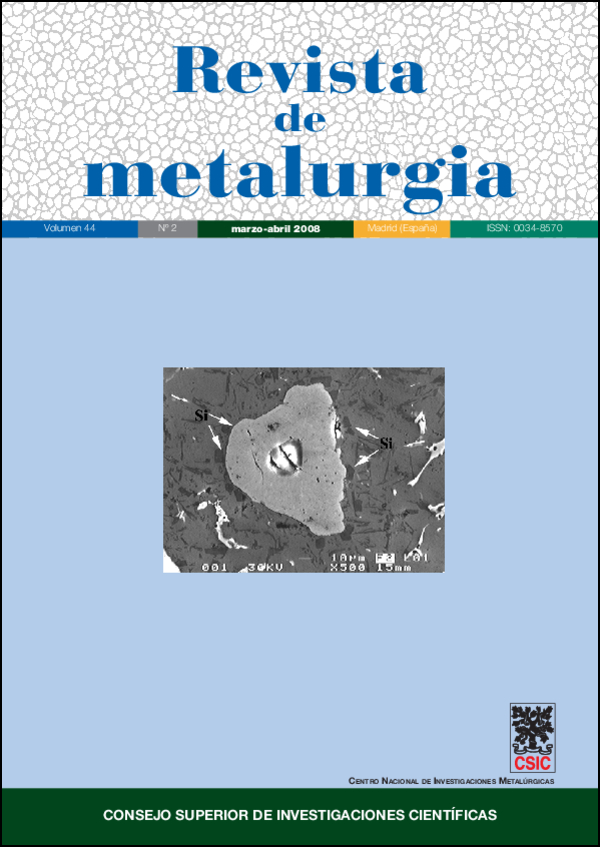Analysis of the hydrogen absorption and its influence on mechanical behaviour of five iron alloys
DOI:
https://doi.org/10.3989/revmetalm.2008.v44.i2.100Keywords:
Cathodic charging, Hydrogen, Mechanical property, Glow discharge optical emission spectroscopy, Steels, Cast ironsAbstract
A study of the influence of hydrogen on the mechanical behaviour of five iron alloys with different carbon state, morphology and content (as spheroidal or lamellar graphite or combined as CFe3) is described here. Experimental observations from tensile (carried out at different crosshead speeds), Charpy impact resistance, hardness, fracture toughness tests and fractographic analysis show that internal or dissolved hydrogen, apart from producing a significant loss of ductility, hardens steels and softens cast irons. The results also provide convincing evidence of the important role that the strain rate plays in the mechanism of hydrogen induced cracking. Additionally, glow discharge optical emission spectroscopy (GDOES) technique is used to evaluate the concentration of hydrogen that has been absorbed by the samples as a function of depth and time. It can be deduced from the innovative use of this technique not only that diffusivity of hydrogen in ductile cast irons is greater than in steels or grey cast irons, but also that hydrogen interacts with different trapping sites.
Downloads
References
[1] R. Requiz, N. Vera Y S. Camero, Rev. Metal. Madrid 40 (2004) 30-38.
[2] R. Garber, I.M. Bernstein Y A.W. Thompson, Scripta Metall. 10 (1976) 341-345. doi:10.1016/0036-9748(76)90089-2
[3] A.W. Thompson, Proc. Am. Petrol. Inst. Ref. Dep., Toronto, Canadá, 1978, API, Washington, Estados Unidos, 1978, pp. 317-326.
[4] A.W. Thompson, Plat. Surf. Finish. 65 (1978) 36-44.
[5] W.M. Robertson Y A.W. Thompson, Metall. Trans. A 11 (1980) 553-557. doi:10.1007/BF02670691
[6] J.E. Costa Y A.W. Thompson, Metall. Trans. A 125 (1981) 761-771.
[7] A.W. Thompson E I.M. Bernstein, Proc. 3rd Int. Conf. Effect of Hydrogen on Behavior of Materials, Moran, Estados Unidos, 1981, Metallurgical Society of AIME, Warrendale, Estados Unidos, 1981, pp. 291-308.
[8] J.E. Costa Y A.W. Thompson, Metall. Trans. A 13 (1982) 1.315-1.318.
[9] R.A. Oriani, Ann. Rev. Mater. Sci. 8 (1978) 327-357. doi:10.1146/annurev.ms.08.080178.001551
[10] R.A. Oriani Y P.H. Josephic, Metall. Trans. A 11 (1980) 1.809-1.820.
[11] R.A. Oriani, Atom. Fract. 5 (1983) 795-798.
[12] R. Gibala Y A.J. Kumnick (Ed.), Hydrogen embrittlement and stress corrosion cracking, Ed. ASM, Metals Park (Ohio), Estados Unidos, 1986, pp. 43-59.
[13] J.P. Hirth, Metall. Trans. A 11 (1980) 861-890. doi:10.1007/BF02654700
[14] J.P. Hirth Y O.A. Onyewuenyi, Proc. 2nd Int. Conf. Environmental Degradation of Engineering Materials, Blacksburg, Estados Unidos, 1981, Va Polytech Inst, Lab for the Study of Environmental Degradation of Engineering Materials, Blacksburg, Estados Unidos, 1981, pp. 133-146.
[15] S.X. Xie Y J.P. Hirth, Mater. Sci. Eng. 60 (1980) 207-212.
[16] J.F. Newman Y L.L. Shreir, J. Iron Steel Inst. 207 (1969) 1.369-1.372.
[17] P. Rozenak, E. Sironis, B. Ladna, H.K. Birnbaum Y S. Spooner, J. Alloy. Comp. 387 (2005) 201-210. doi:10.1016/j.jallcom.2004.06.041
[18] A. Suárez Y J. Fernández, Anales de Mecánica de la Fractura: XXI. Encuentro el Grupo Español de la Fractura, Punta Umbría, España, 2004, Grupo Español de la Fractura, España, 2004, pp. 258-262.
[19] S.A. Golovanenko, V.N. Zikeev, E.B. Serebryanaya Y L.V. Popova, Met. Sci. Heat Treat. 20 (1978) 3-14. doi:10.1007/BF00670433
[20] R. Gibala Y A.J. Kumnick (Ed.), Hydrogen embrittlement and stress corrosion cracking, Ed. ASM, Metals Park (Ohio), Estados Unidos, 1986, pp. 3-27.
[21] G.M. Pressouyre, Metall. Trans. A 14 (1983) 2.189-2.193.
[22] G.M. Pressouyre, Acta Metall. 28 (1980) 895-911. doi:10.1016/0001-6160(80)90106-6
[23] W.M. Robertson Y A.W. Thompson, Metall. Trans. A 11 (1980) 553-557. doi:10.1007/BF02670691
[24] R. Gibala Y A.J. Kumnick (Ed.), Hydrogen embrittlement and stress corrosion cracking, Ed. ASM, Metals Park (Ohio), Estados Unidos, 1986, pp. 61-77.
[25] G.P. Tiwari, A. Bose, J.K Chakravartty, S.L. Wadekar, M.K. Totlani, R.N. Arya Y R.K. Fotedar, Mater. Sci. Eng. A 286 (2000) 269-281. doi:10.1016/S0921-5093(00)00793-0
[26] C.D. Beachem, Metal. Trans. A 3-2 (1972) 437-451.
[27] H.K. Birnbaum Y P. Sofronis, Int. Conf. Effect of hydrogen on the behaviour of Materials, Moran, Estados Unidos, 1994, Minerals, Metals and Materials Society, 1996, pp. 15-34.
[28] M. Wang, E. Akiyama Y K. Tsuzaki, Scr. Mater. 53 (2005) 713-718. doi:10.1016/j.scriptamat.2005.05.014
[29] J.A. Álvarez, F. Gutiérrez-Solana Y J.J. González, Fatigue. Fract. Eng. Mat. & Struct. 20 (1997) 717-727.
[30] R. Nishimura Y Y. Maeda, Corros. Sci. 46 (2004) 769-785. doi:10.1016/j.corsci.2003.08.001
[31] M. Wang, E. Akiyama Y K. Tsuzaki, Scr. Mater. 53 (2005) 713-718. doi:10.1016/j.scriptamat.2005.05.014
[32] W. Dietzel, M. Pfuff Y G.G. Juilfs, Mater. Sci. Forum 482 (2005) 11-19.
[33] S.-Y. Chou Yw.-T. Tsai, Mater. Chem. Phys. 60 (1999) 137-142. doi:10.1016/S0254-0584(99)00077-2
[34] X.Q. Wu E I.S. Kim, Mater. Sci. Eng. A 348 (2003) 309-318. doi:10.1016/S0921-5093(02)00737-2
[35] H.P. Van Leeuwen, Materialprüfung 16 (1974) 263-269.
[36] J.K. Tien, A.W. Thompson, I.M. Bernstein Y R.J. Richards, Metall. Trans. A 7 (1976) 821-829. doi:10.1007/BF02644079
[37] C. Hwang Y I.M. Bernstein, Scr. Metall. 17-11 (1983) 1.299-1.304.
[38] J.P. Hirth Y H.H. Jonson, Atom. Fract. 5 (1983) 771-787.
[39] C.A. Zzpffe, Wire Wire Prod. 22 (1947) 351-379.
[40] A.S. Tetelman, C.N.J. Wagner Y W.D. Robertson, Acta Metall. 9 (1961) 205-215. doi:10.1016/0001-6160(61)90070-0
[41] R.B. Heady, Corrosion 33 (1977) 441-447.
[42] R.A. Oriani, Ber. Bunsenges. Phys. Chem. 76 (1972) 848-856.
[43] G.M. Pressouyre, Acta Metall. 28 (1980) 895-911. doi:10.1016/0001-6160(80)90106-6
Downloads
Published
How to Cite
Issue
Section
License
Copyright (c) 2008 Consejo Superior de Investigaciones Científicas (CSIC)

This work is licensed under a Creative Commons Attribution 4.0 International License.
© CSIC. Manuscripts published in both the printed and online versions of this Journal are the property of Consejo Superior de Investigaciones Científicas, and quoting this source is a requirement for any partial or full reproduction.
All contents of this electronic edition, except where otherwise noted, are distributed under a “Creative Commons Attribution 4.0 International” (CC BY 4.0) License. You may read the basic information and the legal text of the license. The indication of the CC BY 4.0 License must be expressly stated in this way when necessary.
Self-archiving in repositories, personal webpages or similar, of any version other than the published by the Editor, is not allowed.
















